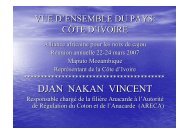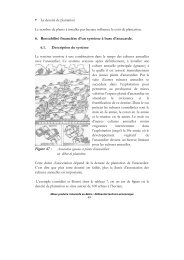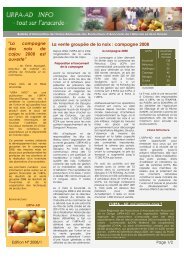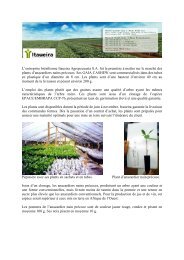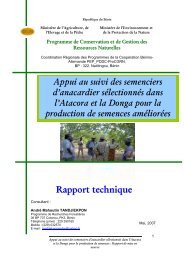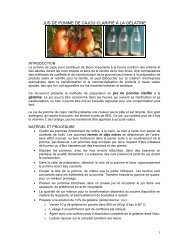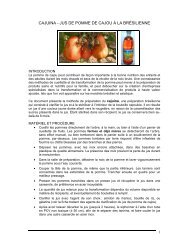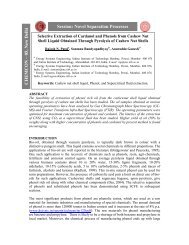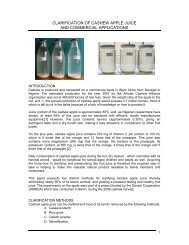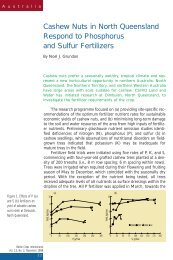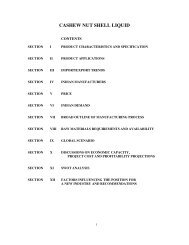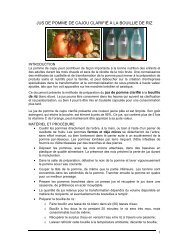Protective Coatings for Heavy Duty and Marine Applications by ...
Protective Coatings for Heavy Duty and Marine Applications by ...
Protective Coatings for Heavy Duty and Marine Applications by ...
You also want an ePaper? Increase the reach of your titles
YUMPU automatically turns print PDFs into web optimized ePapers that Google loves.
<strong>Protective</strong> <strong>Coatings</strong> <strong>for</strong> <strong>Heavy</strong> <strong>Duty</strong> <strong>and</strong> <strong>Marine</strong> <strong>Applications</strong> <strong>by</strong><br />
Means of Surface Tolerant Anti-corrosive Paints based on Epoxy<br />
Resins cured <strong>by</strong> Phenalkamines.<br />
Jean-Luc Dallons, Global Marketing Manager, Cardolite Corp.<br />
Abstract<br />
Phenalkamines derived from Cashew Nutshell liquid are very per<strong>for</strong>ming curing agents <strong>for</strong><br />
epoxy resins.<br />
Paint <strong>for</strong>mulations based on phenalkamine curing agents bring about protective coatings with<br />
outst<strong>and</strong>ing corrosion resistance.<br />
These coatings are very surface tolerant, namely, can be applied on non well prepared<br />
metallic surface even under humid conditions.<br />
Phenalkamines cure epoxy resins along a broad range of temperatures.<br />
<strong>Coatings</strong> based on phenalkamines are particularly suitable <strong>for</strong> heavy duty industrial <strong>and</strong><br />
marine applications.<br />
Introduction<br />
Steel is one of the most popular construction material. It is used all over the world to build<br />
bridges, ships, transportation vehicles, stadia <strong>and</strong> plants.<br />
Steel has many advantages, namely its versatility <strong>and</strong> its availability. The main disadvantage<br />
of steel, however, is its tendency to corrode, there<strong>for</strong>e requiring a protective coating.<br />
Corrosion is a natural phenomenon that affects the appearance of the ship, bridge or any other<br />
construction. Peeling paint is a sign of poor maintenance <strong>for</strong> the public <strong>and</strong> can induce an<br />
unsafe feeling (1). The industry is there<strong>for</strong>e more <strong>and</strong> more requiring high quality coatings.<br />
Nowadays, however, quality can sometimes be downsized due to cost reductions programs.<br />
Furthermore, environmental regulations are pushing the industry to reduce its air emissions.<br />
As a consequence, replacement of existing per<strong>for</strong>ming materials <strong>by</strong> non polluting ones is a<br />
very challenging project.<br />
High quality, lower cost <strong>and</strong> environmental friendly oppose frequently one another. By<br />
plotting these three requirements, we get a triangle (fig.1) which shows clearly that optimising<br />
one requirement is most of the time done to the detriment of the others. Indeed, focusing on<br />
cost reduction will more likely lead to a poor per<strong>for</strong>ming material. Environmental friendly<br />
coatings are often less per<strong>for</strong>ming than conventional ones or at least not so easy to h<strong>and</strong>le <strong>and</strong><br />
there<strong>for</strong>e more expensive.<br />
As a general rule of thumb, the best solution is always found through the best compromise.<br />
This paper will demonstrate that the best solution is brought about <strong>by</strong> epoxy 2K coatings<br />
based on phenalkamines curing agents.<br />
1
Figure 1 . Industry Requirements.<br />
Cost Reduction<br />
High Quality<br />
Environment<br />
Phenalkamine Technology(2-6)<br />
Phenalkamines are epoxy curing agents obtained through amination of polymerized cardanol,<br />
a chemical derived from the cashew nutshell liquid (CNSL). This is there<strong>for</strong>e a renewable raw<br />
material.<br />
The chemical <strong>for</strong>mula of cardanol (figure 2) illustrates the particular properties that this<br />
backbone unit will confer to coatings. Cardanol is very difficult to synthesize through a<br />
conventional chemical process as the aliphatic side chain is found in the meta position<br />
regarding the phenol group which actually orientates any further substitution to the positions<br />
ortho or para. Nature can however make it.<br />
Figure 2 . Cardanol Structure <strong>and</strong> Properties.<br />
OH<br />
Reactivity Enhancement -<br />
Adhesion<br />
C 7 H 14 -CH=CH-CH 2 -CH=CH-C 3 H 7<br />
Chemical Resistance<br />
Water<br />
Resistance<br />
As shown <strong>by</strong> figure 2, the hydroxyl group will provide adhesion <strong>and</strong> can also act as catalyst<br />
<strong>for</strong> the curing reaction between amine <strong>and</strong> epoxy functions. Phenalkamines are there<strong>for</strong>e fast<br />
curing agents.<br />
2
The aliphatic chain will confer a water repellence to the coating whilst chemical resistance<br />
will be obtained thanks to the aromatic ring.<br />
Cost Reduction<br />
Industry can reduce cost through :<br />
‣ Shortening the down-times<br />
‣ Getting back to service as fast as possible<br />
‣ Reducing the total application cost<br />
‣ Being able to coat all over the year (“All Season Cure”)<br />
‣ Reducing operation <strong>for</strong> substrate pre-treatment<br />
Hardness of the film is rapidly achieved when using phenalkamine curing agents, there<strong>for</strong>e<br />
shortening the down-times between two subsequent coating applications. Development of<br />
hardness with phenalkamine compared to conventional polyamide is illustrated <strong>by</strong> figure 3.<br />
Figure 3 . Hardness Development.<br />
Persoz (sec.)<br />
180<br />
160<br />
140<br />
120<br />
100<br />
80<br />
60<br />
40<br />
20<br />
0<br />
0 10 20 30 40 50 60<br />
Time (h)<br />
Phenalkamine<br />
PAA<br />
A freshly painted or repaired object requires always a certain time be<strong>for</strong>e to be put into<br />
service. Reducing this waiting time is obviously interesting to an economic point of view.<br />
As can be seen in figure 4, phenalkamines fast cure epoxy resins even at low temperature<br />
which is not the case <strong>for</strong> conventional curing agents. Epoxy 2K paints based on<br />
phenalkamines are there<strong>for</strong>e an “All Season Cure” system. 2 coats a day as well as coating<br />
during the winter season in cold geographical areas is not anymore a dream but a reality.<br />
3
Figure 4 . Curing at Different Temperatures<br />
100<br />
90<br />
80<br />
70<br />
Conversion (%)<br />
60<br />
50<br />
40<br />
30<br />
20<br />
10<br />
0<br />
0 1 2 3 4 5 6 7 8 9 10<br />
Curing Time (Days)<br />
Phenalkamine @ 24 °C Phemalkamine @ 4 °C Phenalkamine @ -5°C Polyamide @ 5 °C<br />
Phenalkamines, perceived as very expensive materials, reveal to be very cost effective.<br />
Due to their very low AHEW number, <strong>for</strong>mulators are using less curing agents as it is<br />
illustrated in table 1.<br />
Table 1 . Formulation with Phenalkamines<br />
Hardener<br />
Phenalkamine<br />
(65 %, AHEW : 174)<br />
PAAad<br />
(70 %, AHEW : 340)<br />
PAAad<br />
(60 %, AHEW : 520)<br />
PAAad<br />
(50 %, AHEW : 785)<br />
Amount to Cure 100 g of<br />
Epikote 1000 x 75<br />
26 g<br />
51 g<br />
78 g<br />
118 g<br />
Cost of 1 kg of paint containing phenalkamine curing agent is indeed almost doubled compare<br />
to a conventional epoxy paint.<br />
However, prices are virtually the same if one calculates per litre of dry paint.<br />
Phenalkamine based paint, due to easier h<strong>and</strong>ling <strong>and</strong> surface preparation tolerance, can<br />
drastically drop the total cost of the entire paint process (figure 5).<br />
4
Figure 5. Cost of Phenalkamine Based Coating.<br />
Total paint cost evaluation<br />
100%<br />
90%<br />
80%<br />
Costs in % of Traditional system<br />
70%<br />
60%<br />
50%<br />
40%<br />
30%<br />
20%<br />
10%<br />
0%<br />
Polyaminoamide/200µ/ 3 coats/SA 2,5 Cardolite/200µ/2 coats/SA 2,5 Cardolite/200µ/1 coats/SA 2,5 Cardolite/200µ/1 coats/ST 2<br />
Paint cost Application Pretreatment<br />
To achieve the same coating protection, paints based on phenalkamines require only two<br />
coating layers <strong>and</strong> even a single one compared to the three layers that must be applied with<br />
conventional polyamide systems. Finally, epoxy 2 K based on phenalkamines can be used on<br />
a non well prepared substrate like slightly rusted steel (ST2) as shown in figure 6.<br />
Figure 6. Surface Tolerant Coating.<br />
Starting<br />
Panel<br />
After 1500<br />
hr Salt<br />
Spray<br />
5
High Quality <strong>Coatings</strong><br />
Whilst being a cost effective coating system, epoxy 2K with phenalkamines as curing agents<br />
are proven very high quality coatings.<br />
Phenalkamines provide indeed a very outst<strong>and</strong>ing anti-corrosion property <strong>and</strong> can be used on<br />
steel, galvanized steel <strong>and</strong> Aluminum as shown in figure 7.<br />
Figure 7 . Anti-corrosion <strong>Coatings</strong> on Different Substrates.<br />
Steel Aluminum Galvanized Steel<br />
After 750 hr salt spray<br />
Phenalkamines, compared with polyamides, cycloaliphatic amines or Manich bases, provide<br />
also the best water repellence on epoxy 2K coatings like shown in figure 8.<br />
Figure 8 . Water Resistance<br />
2,5<br />
Weight Change (%)<br />
2<br />
1,5<br />
1<br />
Phenalkamine<br />
Polyamide<br />
Cycloaliphatic<br />
Mannich<br />
0,5<br />
0<br />
25 °C 65 °C<br />
Immersion Temperature<br />
6
Environment<br />
Fast curing phenalkamines can be <strong>for</strong>mulated as high solids coating as it is illustrated <strong>by</strong><br />
table 2.<br />
Table 2 . High Solids Formulations<br />
Epoxy<br />
16.3<br />
22.8<br />
Solvent<br />
10.4<br />
8.3<br />
Part A<br />
Rutile<br />
15.6<br />
15.1<br />
Talc<br />
33.4<br />
32.3<br />
Barite<br />
9.3<br />
9.1<br />
Part B<br />
Phenalkamine<br />
15.1<br />
12.4<br />
VOC<br />
(calculated)<br />
265 g/l<br />
285 g/l<br />
Some phenalkamines can even be <strong>for</strong>mulated as 100 % solid, namely solvent free <strong>and</strong> be used<br />
in contact with potable water (2).<br />
Conclusions<br />
The paint industry dream to achieve a low cost, high quality <strong>and</strong> environment friendly<br />
<strong>for</strong>mulations is now a reality through the use of phenalkamine curing agents <strong>for</strong> epoxy resins.<br />
This system offers indeed :<br />
‣ All Season Cure <strong>Coatings</strong><br />
‣ Excellent combination between fast curing <strong>and</strong> workable pot life at both ambient <strong>and</strong><br />
low temperatures<br />
‣ Surface Tolerant <strong>Applications</strong><br />
‣ Very High Solids to even 100 % solid <strong>for</strong>mulations<br />
‣ Outst<strong>and</strong>ing anti-corrosion properties on different metallic substrates.<br />
References<br />
1) Perkins, P., JPCL, October 2003, 56-62.<br />
2) Dallons, J.L., PPCJ, to be published.<br />
3) R.A Gardiner, Modern Paint <strong>and</strong> Coating, July 1978<br />
4) Z.Dai, A. Constantinescu, A. Dahal, C. Ford, SPI-ERF Conference, September<br />
1994<br />
5) E. Van Nevel, PPCJ, April 1995<br />
6) M.C. Liepins, Welt der Farben, 9/2002 (12-13)<br />
7




